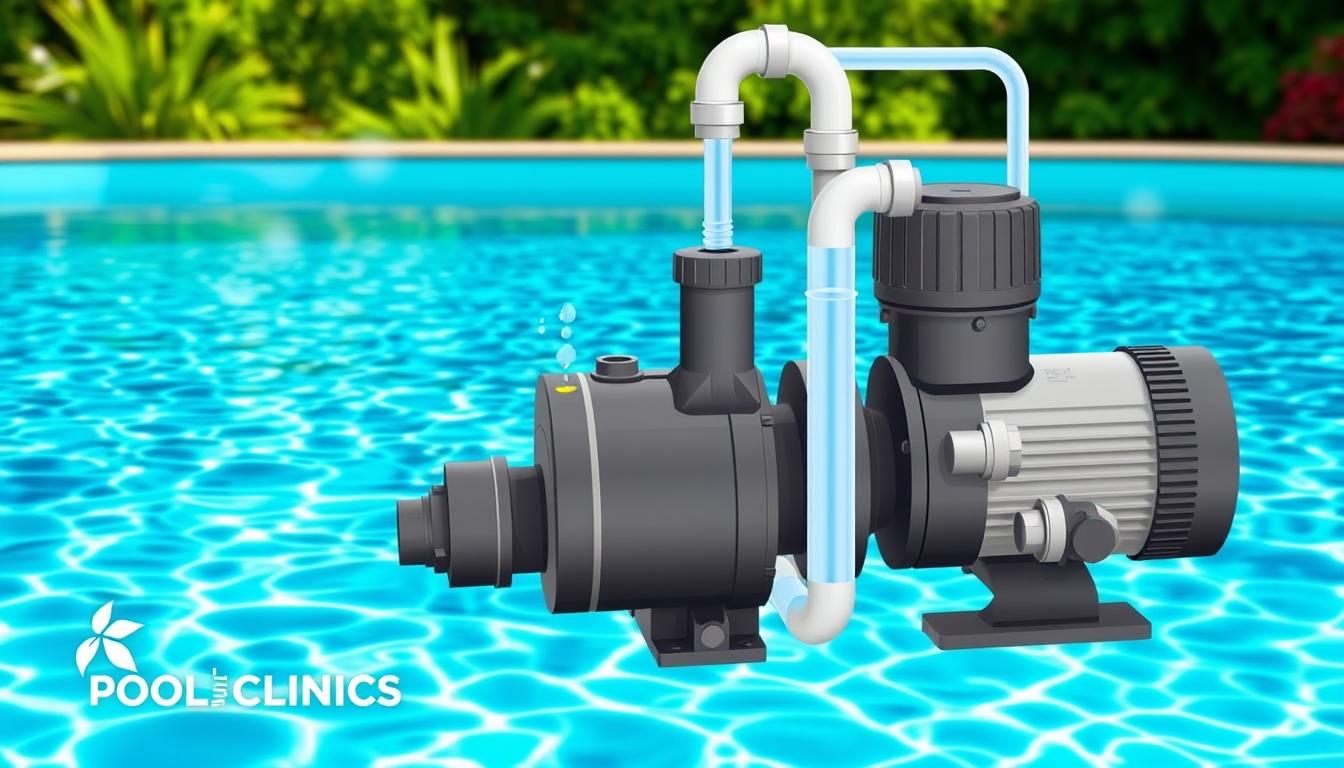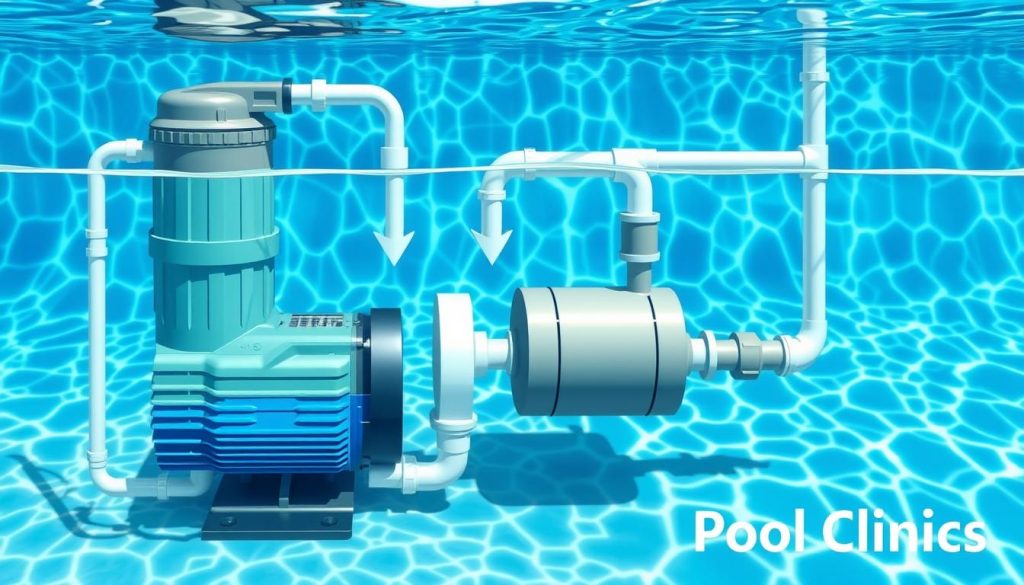
Pool pump recirculation is vital for a clean, safe swimming environment. It’s different from filtering but equally important. Let’s explore how recirculation keeps your pool water crystal clear.
Recirculation removes impurities and maintains safe water for swimmers. Two main methods exist: skimmer recirculation and overflow recirculation schemes.
The pool pump is the heart of the filtration system. Its flow rate and plumbing affect recirculation efficiency.
The recirculate function redirects water without filtering it. This improves circulation and oxygenation, essential for a healthy swimming environment.
Proper maintenance requires understanding the difference between filtering and recirculating. Both processes contribute to keeping your pool in top condition.
Key Takeaways
- Pool water recirculation is crucial for maintaining clear and safe water for swimmers.
- Skimmer and overflow recirculation schemes are the two main treatment methods for pool water.
- The pool pump’s flow rate and plumbing determine the efficiency of the recirculation process.
- Recirculating pool water allows for better circulation and oxygenation without filtering.
- Understanding the difference between filtering and recirculating is essential for proper pool maintenance.
Understanding Pool Water Recirculation
Pool water recirculation keeps swimming environments clean and safe. It removes impurities and balances chemicals by circulating water through filters. This process ensures crystal-clear, hygienic water for swimmers.
Regular maintenance of pool pumps is crucial. Swimming pool system checkups keep the recirculation process running smoothly. These steps help maintain an efficient and enjoyable pool experience.

The Importance of Pool Water Circulation
Effective pool water circulation is vital for several reasons. It distributes chemicals evenly, ensuring properly sanitized and safe water. It prevents stagnant areas where algae and bacteria can grow.
Good circulation also maintains comfortable water temperature. It distributes heat evenly, especially when using pool heaters or chillers. Regular equipment repair keeps the circulation system working well.
Skimmer vs. Overflow Recirculation Systems
Two main types of pool water recirculation systems exist: skimmer and overflow. Skimmer systems are common in residential in-ground pools. They use skimmers and bottom drains to draw water.
Overflow systems are found in commercial and high-end residential pools. Water flows over the pool’s edge into a gutter or channel. It’s then pumped through filters and returned to the pool.
| Recirculation System | Skimmer | Overflow |
|---|---|---|
| Water Level | Lower than pool edge | Flush with pool edge |
| Intake Method | Skimmers and bottom drains | Overflow channels or gutters |
| Return Method | Return jets | Bottom outlets or wall inlets |
| Common Applications | Residential in-ground pools | Commercial and high-end residential pools, infinity pools |
Regular maintenance is key for both systems. Pool pump upkeep and system inspections ensure optimal water circulation. Prompt equipment repairs help maintain a clean and safe swimming environment.
The Role of Pool Pumps in Water Recirculation
Pool pumps are vital for a pool’s filtration system. They draw water from the pool and push it through the filter. This process keeps the water clean, clear, and safe for swimming.
Choosing the Right Pool Pump for Efficient Recirculation
Picking the right pool pump is key for efficient water recirculation. Consider your pool’s size, filtration needs, and desired turnover rate. Choose a pump with the right flow rate and head pressure for best results.
Energy-efficient pool pumps can save you money on operating costs. Variable speed pumps adjust to your pool’s needs. This leads to big energy savings over time.
Calculating Filtration Time and Pump Sizing
To size your pump, look at your pool’s water volume and the pump’s flow rate. Aim to turn over all the water at least once every 12 hours. This ensures the whole pool gets filtered twice daily.
Use this formula to figure out how long to filter:
| Pool Volume (in gallons) | Pump Flow Rate (in gallons per minute) | Filtration Time (in hours) |
|---|---|---|
| 20,000 | 50 | 6.7 |
| 30,000 | 75 | 6.7 |
| 40,000 | 100 | 6.7 |
The right pump size helps your system work well. It keeps your pool clean and healthy for swimming.
Energy-Efficient Pool Pumps for Cost Savings
Energy-efficient pool pumps can save you money over time. Variable speed pumps can run slower when the pool isn’t used. This cuts energy use without hurting water quality.
Hot Spring’s SilentFlo 5000 system uses a small electromagnetic motor. It runs all day using only ten cents of power. This system keeps water clear by filtering it non-stop.
Choose energy-efficient pumps sized right for your pool. You’ll get great water circulation while saving money and helping the environment.
When to Use the Recirculate Function on a Pool Pump
The recirculate function on a pool pump helps maintain water quality and circulation. It’s useful for temporary adjustments to the pool’s filtration system. Understanding when to use it can help address common issues effectively.
Addressing Cloudy Pool Water
The recirculate function is often used when dealing with cloudy pool water. Many pool owners use it when adding chemicals that cause cloudiness. Recirculating helps dissolve chemicals and improve oxygenation, clearing up the water.
This temporary solution maintains water quality while addressing the cloudiness cause. It allows pool owners to keep their pools in top condition.
Distributing Pool Chemicals Evenly
After adding new chemicals, it’s crucial to distribute them evenly throughout the water. The recirculate function helps mix chemicals thoroughly before filtration begins. Running the pump on recirculate after adding chemicals ensures uniform distribution.
This leads to more effective chemical treatment and balanced pool water circulation. It’s a key step in maintaining a healthy pool environment.
Maintaining Proper Water Temperature
For pools with heaters or chillers, recirculation helps maintain consistent water temperature. It spreads warmer or cooler water uniformly, minimizing hot or cold spots. This feature extends the swimming season and improves comfort.
Many pool owners use recirculation for quicker heating. It increases water circulation, leading to faster temperature changes.
Resolving Chemical Imbalances
The recirculate function is valuable for resolving chemical imbalances in pool water. It thoroughly mixes chemicals, allowing for even treatment throughout the pool. This is crucial when addressing pH or chlorine imbalances.
Many pool owners use recirculation to facilitate accurate chemical testing. After recirculating, they can retest the water and make necessary adjustments.







